|

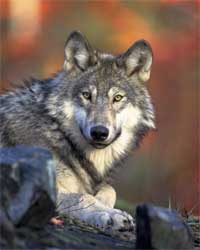 Size: Wolf weight and size can vary greatly worldwide, though both tend to increase proportionally with higher latitudes. Generally speaking, height varies from 0.6 to 0.9 meters (24 to 35 inches) at the shoulder, and weight can range anywhere from 25 to 65 kg (55-143 pounds), making wolves the largest among all wild canids. Although rarely encountered, extreme specimens reaching 80 kg (176 lb.) have been recorded in Alaska and Canada, though some people claim to have seen even larger anomalous individuals (90+ kg) roaming the Yukon, where some of the largest wolves in North America can be found. Customarily, however, wolves will be of a more typical physical capacity, with the females in a given population weighing about twenty percent less than their male counterparts. Wolves can measure anywhere between 1.3 and 2 meters (51 to 78 inches) from nose to tail tip, with the tail itself consisting of approximately one quarter of overall body length. Size: Wolf weight and size can vary greatly worldwide, though both tend to increase proportionally with higher latitudes. Generally speaking, height varies from 0.6 to 0.9 meters (24 to 35 inches) at the shoulder, and weight can range anywhere from 25 to 65 kg (55-143 pounds), making wolves the largest among all wild canids. Although rarely encountered, extreme specimens reaching 80 kg (176 lb.) have been recorded in Alaska and Canada, though some people claim to have seen even larger anomalous individuals (90+ kg) roaming the Yukon, where some of the largest wolves in North America can be found. Customarily, however, wolves will be of a more typical physical capacity, with the females in a given population weighing about twenty percent less than their male counterparts. Wolves can measure anywhere between 1.3 and 2 meters (51 to 78 inches) from nose to tail tip, with the tail itself consisting of approximately one quarter of overall body length.
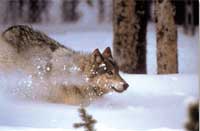 Stamina kings: Wolves are built for stamina, possessing features tailored for long-distance travel. Narrow chests and powerful backs and legs contribute to the wolf's proficiency for efficient locomotion. They are capable of covering several miles trotting at about a 10 km/h (6 mph) pace, though they have been known to reach speeds approaching 65 km/h (40 mph) during a chase (wolves only run fast when testing potential prey). While sprinting thus, wolves can cover up to 5 m (16 ft) per bound. Stamina kings: Wolves are built for stamina, possessing features tailored for long-distance travel. Narrow chests and powerful backs and legs contribute to the wolf's proficiency for efficient locomotion. They are capable of covering several miles trotting at about a 10 km/h (6 mph) pace, though they have been known to reach speeds approaching 65 km/h (40 mph) during a chase (wolves only run fast when testing potential prey). While sprinting thus, wolves can cover up to 5 m (16 ft) per bound.
Special paws: Wolf paws are able to traverse easily through a wide variety of terrains, especially snow. There is a slight webbing between each toe, which allows wolves to move over snow more easily than comparatively hampered prey. Wolves are digitigrade, so the relative largeness of their feet helps to better distribute their weight on snowy surfaces. The front paws are larger than the hind paws, and feature a fifth digit, a dewclaw, that is absent on hind paws. Bristled hairs and blunt claws enhance grip on slippery surfaces, and special blood vessels keep paw pads from freezing. Furthermore, scent glands located between a wolf's toes leave trace chemical markers behind, thereby helping the wolf to effectively navigate over large expanses while concurrently keeping others informed of its whereabouts.
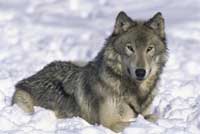 Two-layered coat: A wolf sometimes seems more massive than it actually is due to its bulky coat, which is made of two layers. The first layer consists of tough guard hairs designed to repel water and dirt. The second is a dense, water-resistant undercoat that insulates. Wolves have distinct winter and summer coats that alternate in spring and autumn. Females tend to keep their winter coats further into the spring than males. Two-layered coat: A wolf sometimes seems more massive than it actually is due to its bulky coat, which is made of two layers. The first layer consists of tough guard hairs designed to repel water and dirt. The second is a dense, water-resistant undercoat that insulates. Wolves have distinct winter and summer coats that alternate in spring and autumn. Females tend to keep their winter coats further into the spring than males.
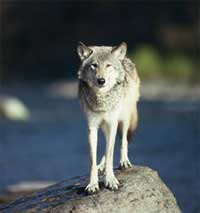 Color: Coloration varies greatly, and runs from gray to gray-brown, all the way through the canine spectrum of white, red, brown, and black. These colors tend to mix in many populations to form predominantly blended individuals, though it is certainly not uncommon for an individual or an entire population to be entirely one color (usually all black or all white). A multicolor coat characteristically lacks any clear pattern other than it tends to be lighter on the animal's underside. Fur color sometimes corresponds with a given wolf population's environment; for example, all-white wolves are much more common in areas with perennial snow cover. Aging wolves acquire a grayish tint in their coats. Color: Coloration varies greatly, and runs from gray to gray-brown, all the way through the canine spectrum of white, red, brown, and black. These colors tend to mix in many populations to form predominantly blended individuals, though it is certainly not uncommon for an individual or an entire population to be entirely one color (usually all black or all white). A multicolor coat characteristically lacks any clear pattern other than it tends to be lighter on the animal's underside. Fur color sometimes corresponds with a given wolf population's environment; for example, all-white wolves are much more common in areas with perennial snow cover. Aging wolves acquire a grayish tint in their coats.

Habitats: Gray wolves, being keystone predators, are integral components of the ecosystems to which they typically belong. The wide range of habitats in which wolves can thrive reflects their adaptability as a species, and includes temperate forests, mountains, tundra, taiga, and grasslands. In the contiguous U.S., with the exception of Minnesota and Wisconsin (where they have a threatened status), they are listed as endangered under the Endangered Species Act of 1973. They continue to be hunted in many areas of the world as perceived threats to livestock, humans and their well-being, as well as for sport.
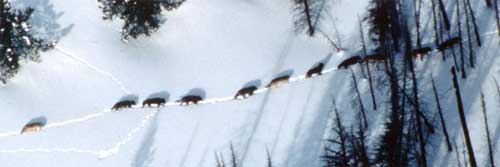
Alpha pair: Normally, only the alpha pair of the pack breeds, which is a kind of organization not uncommon to other pack-hunting canids including the Dhole and the African Hunting dog. Mating occurs between January and April, happening later in the year as latitude increases. A pack usually produces a single litter, though sometimes multiple litters will be born if the alpha male mates with one or more subordinate females. Under normal circumstances, the alpha female will try to prevent this by aggressively dominating other females and physically separating them from the alpha male during the mating season.
Gestation: The gestation period lasts 60 to 63 days, and the pups are born blind, deaf, and completely dependent on their mother. There are 1–14 pups per litter, with the average litter size being about four to six. Pups reside in the den, where they are born, and stay there until they reach about 8 weeks of age (the den is usually on high ground near an open water source, and has an open "room" at the end of an underground/hillside tunnel that can be up to a few meters long). During this time, the pups will become more independent, and will eventually begin to explore the area immediately outside the den before gradually roaming up to a mile away from it. They begin eating regurgitated foods at four weeks – by which time their milk teeth have emerged – and are weaned by six weeks. During the first weeks of development, the mother usually stays with her litter alone, but eventually most members of the pack will contribute to the rearing of the pups in some way.
After two months, the restless pups will be moved to a rendezvous site, which gives them a safe place to reside while most of the adults go out to hunt. An adult or two will stay behind to ensure the safety of the pups. After a few more weeks, the pups are permitted to join the adults if they are able (they tag along as observers until about eight months, by which time they are large enough to actively participate), and will receive first priority on anything killed, their low ranks notwithstanding. Letting the pups fight for the right to eat results in a secondary ranking being formed among them, and lets them practice the dominance/submission rituals that will be essential to their future survival in pack life.
Wolves typically reach sexual maturity after two or three years, at which point many of them will feel compelled to leave their birth packs and search out mates and territories of their own. Wolves that reach maturity generally live between 6 and 9 years in the wild, although in captivity they can live to be twice that age. High mortality rates result in a relatively low life expectancy for wolves on an overall basis. Pups die when food is scarce; they can also fall prey to other predators such as bears, or, less likely, coyotes, foxes, or other wolves. The most significant mortality factors for grown wolves are hunting and poaching by humans, car accidents, and wounds suffered while hunting prey. Wolves are susceptible to the same infections that affect domestic dogs, such as mange, heartworm, rabies and canine distemper, and such diseases can become epidemic, drastically reducing the wolf population in an area.
Wolves can visually communicate an impressive variety of expressions and moods that range from subtler signals – such as a slight shift in weight – to the more obvious ones – like rolling on the back as a sign of complete submission.
A dominant wolf stands stiff legged and tall. The ears are erect and forward, and the hackles bristle slightly. Often the tail is held vertical and curled toward the back. This display shows the wolf's rank to all others in the pack. A dominant lupine may stare penetratingly at a submissive one, pin it to the ground, "ride up" on its shoulders, or even stand on its hind legs.
In active submission, the entire body is lowered, and the lips and ears are drawn back. Sometimes active submission is accompanied by muzzle licking, or the rapid thrusting out of the tongue and lowering of the hindquarters. The tail is placed down, or halfway or fully between the legs, and the muzzle often points up to the more dominant animal. The back may be partially arched as the submissive wolf humbles itself to its superior. (A more arched back and more tucked tail indicate a greater level of submission.)
Passive submission is more intense than active submission. The wolf rolls on its back and exposes its vulnerable throat and underside. The paws are drawn into the body. This is often accompanied by whimpering.
Anger pose: An angry lupine's ears are erect, and its fur bristles. The lips may curl up or pull back, and the incisors are displayed. The wolf may also snarl.
Frightened look: A frightened wolf tries to make its body look small and therefore less conspicuous. The ears flatten down against the head, and the tail may be tucked between the legs, as with a submissive wolf. There may also be whimpering or barks of fear, and the wolf may arch its back.
A defensive wolf flattens its ears against its head.
An aggressive wolf snarls and its fur bristles. The wolf may crouch, ready to attack if necessary.
Pulling back of the ears shows a lupine is suspicious. In addition, the wolf narrows its eyes. The tail of a wolf that senses danger points straight out, parallel to the ground.
A relaxed wolf's tail points straight down, and the wolf may rest sphinxlike or on its side. The wolf's tail may also wag. The further down the tail droops, the more relaxed the wolf is.
An aroused wolf's tail points straight out, and the wolf may crouch as if ready to spring.
As dogs do, a lupine may wag its tail if it is in a joyful mood. The tongue may loll out of the mouth.
A wolf that is hunting is tensed, and therefore the tail is horizontal and straight.
A playful lupine holds its tail high and wags it. The wolf may frolic and dance around, or bow by placing the front of its body down to the ground, while holding the rear high, sometimes wagged. This is reminiscent of the playful behavior executed in domestic dogs.
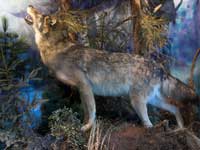 Wolves howl for several reasons. Howling helps pack members keep in touch, allowing them to effectively communicate in thickly forested areas or over great distances. Furthermore, howling helps to summon pack members to a specific location. Howling can also serve as a declaration of territory, as portrayed by a dominant wolf's tendency to respond to a human imitation of a "rival" individual in an area that the wolf considers its own. This behavior is also stimulated when a pack has something to protect, such as a fresh kill. As a rule of thumb, large packs will more readily draw attention to themselves than will smaller packs. Adjacent packs may respond to each others' howls, which can mean trouble for the smaller of the two. Thus, wolves tend to howl with great care. Wolves howl for several reasons. Howling helps pack members keep in touch, allowing them to effectively communicate in thickly forested areas or over great distances. Furthermore, howling helps to summon pack members to a specific location. Howling can also serve as a declaration of territory, as portrayed by a dominant wolf's tendency to respond to a human imitation of a "rival" individual in an area that the wolf considers its own. This behavior is also stimulated when a pack has something to protect, such as a fresh kill. As a rule of thumb, large packs will more readily draw attention to themselves than will smaller packs. Adjacent packs may respond to each others' howls, which can mean trouble for the smaller of the two. Thus, wolves tend to howl with great care.
Wolves will also howl for communal reasons. Some scientists speculate that such group sessions strengthen the wolves' social bonds and camaraderie—similar to community singing among humans. During such choral sessions, wolves will howl at different tones and varying pitches, which tends to prevent a listener from accurately estimating the number of wolves involved. This concealment of numbers makes a listening rival pack wary of what action to take. For example, confrontation could mean bad news if the rival pack gravely underestimates the howling pack's numbers.
Observations of wolf packs suggest that howling occurs most often during the twilight hours, preceding the adults' departure to the hunt and following their return. Studies also show that wolves howl more frequently during the breeding season and subsequent rearing process. The pups themselves begin howling towards the end of July, and can be provoked into howling sessions relatively easily over the following two months. Such indiscriminate howling usually has a communicative intent, and has no adverse consequences so early in a wolf's life. Howling becomes less indiscriminate as wolves learn to distinguish howling pack members from rival wolves.
Growling, used in tandem with bared teeth, is the most visual and effective warning wolves use. Wolf growls have a distinct, deep, bass-like quality, and are used much of the time as a threat, though they are not always necessarily used for defense. Wolves will also growl at other wolves while being aggressively dominant.
Wolves can also bark, which they do when nervous or to warn other wolves of danger. Wolves bark very discreetly, and will not generally bark loudly or repeatedly as dogs do; rather, they use a low-key, breathy "whuf" sound to get attention immediately from other wolves. Wolves will also "bark-howl" by adding a brief howl to the end of a bark. Wolves bark-howl for the same reasons they normally bark. Actually, pups bark and bark-howl much more frequently than adults, using such vocalizations as cries for attention, care, or food.
Wolves can also whimper, which they usually do only while submitting to other wolves. Wolf pups will whimper when they need a reassurance of security from their parents or other wolves.
Wolves, like other canines, use scent marking to lay claim to anything from territory to fresh kills. Alpha wolves scent mark the most often, with males doing so more than females. The most widely used scent marker is urine. Male alpha wolves urine-mark objects using a raised-leg stance (all females squat) so as to enforce rank and territory. They will also use such marks to identify food caches and to claim kills on behalf of the whole pack. Defecation markers are used for the same purposes as urine marks, and serve as a more visual warning, as well. These types of scent markings are particularly useful for navigational purposes, keeping the pack from traversing the same terrain too often while also allowing each individual to be aware of the whereabouts of its pack members. Above all, though, scent marking is used to notify other wolves and packs that a given territory is occupied, and that they should therefore tread cautiously.
Wolves have scent glands all over their bodies, including at the base of the tail, between toes, and in the eyes, genitalia, and skin. Pheromones secreted by these glands identify each individual wolf. A dominant wolf will "rub" his or her body against subordinate wolves to mark such individuals as being members of a particular pack. Wolves may also "paw" dirt to release pheromones in lieu of urine marking.
Odor: That wolves rely so heavily on odoriferous signals testifies greatly to their olfactory capabilities. Wolves can pick up any scent, including marks, from great distances, and can distinguish among them just as well or better than humans can distinguish other humans visually.
Social predators: Wolves function as social predators and hunt in packs organized according to strict, rank-oriented social hierarchies. It was originally thought that this comparatively high level of social organization had more to do with hunting success, and while this still may be true to a certain extent, emerging theories suggest that the pack has less to do with hunting and more to do with reproductive success.
Leaders: The pack is led by the two individuals that sit atop the social hierarchy — the alpha male and the alpha female. The alpha pair (of whom only one may be the "top" alpha) has the greatest amount of social freedom compared to the rest of the pack, but they are not "leaders" in the human sense of the term. The alphas do not give the other wolves orders; rather, they simply have the most freedom in choosing where to go, what to do, and when to do it. Possessing strong instincts for fellowship, the rest of the pack usually follows.
While most alpha pairs are monogamous with each other, there are exceptions. An alpha animal may preferentially mate with a lower-ranking animal, especially if the other alpha is closely related (a brother or sister, for example). The death of one alpha does not affect the status of the other alpha, who will quickly take another mate.
Usually, only the alpha pair is able to successfully rear a litter of pups (other wolves in a pack may breed, but will usually lack the resources required to raise the pups to maturity). All the wolves in the pack assist in raising wolf pups. Some mature individuals, usually females, may choose to stay in the original pack so as to reinforce it and help rear more pups. Most, males particularly, will disperse, however.
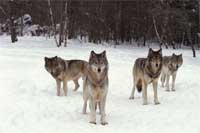 The size of the pack may change over time and is controlled by several factors, including habitat, personalities of individual wolves within a pack, and food supply. Packs can contain between two and 20 wolves, though an average pack consists of six or seven. New packs are formed when a wolf leaves its birth pack and claims a territory. Lone wolves searching for other individuals can travel very long distances seeking out suitable territories. Dispersing individuals must avoid the territories of other wolves because intruders on occupied territories are chased away or killed, a behavior that may explain wolf "predation" of dogs. Most dogs, except perhaps large, specially bred attack dogs, do not stand much of a chance against a pack of wolves protecting its territory from an unwanted intrusion. The size of the pack may change over time and is controlled by several factors, including habitat, personalities of individual wolves within a pack, and food supply. Packs can contain between two and 20 wolves, though an average pack consists of six or seven. New packs are formed when a wolf leaves its birth pack and claims a territory. Lone wolves searching for other individuals can travel very long distances seeking out suitable territories. Dispersing individuals must avoid the territories of other wolves because intruders on occupied territories are chased away or killed, a behavior that may explain wolf "predation" of dogs. Most dogs, except perhaps large, specially bred attack dogs, do not stand much of a chance against a pack of wolves protecting its territory from an unwanted intrusion.
The hierarchy – led by the alpha male and female – affects all activity in the pack to some extent. In most larger packs, there are two separate hierarchies in addition to an overbearing one: the first consists of the males, led by the alpha male, and the other consists of the females, led by the alpha female. In this situation, the alpha male usually assumes the "top" alpha position, though alpha females have been known to take control over entire packs in some cases. The male and female hierarchies are interdependent, and are maintained constantly by aggressive and elaborate displays of dominance and submission.
After the alpha pair, there may also, especially in larger packs, be a beta wolf or wolves – a "second-in-command" to the alphas. Betas typically assume a more prominent role in assisting with the upbringing of the alpha pair's litter, often serving as surrogate mothers or fathers while the alpha pair is away. Beta wolves are the most likely to challenge their superiors for the role of the alpha, though some betas seem content with being second, and will sometimes even let lower ranking wolves leapfrog them for the position of alpha should circumstances necessitate such a happening (death of the alpha, etc.). More ambitious beta wolves, however, will only wait so long before challenging for the top spot; unless, of course, they choose to disperse and create their own pack instead.
Loss of rank can happen gradually or suddenly. An older wolf may simply choose to give way when a motivated challenger presents itself, yielding its position without bloodshed. On the other hand, the challenged individual may choose to fight back, with varying degrees of intensity. While the majority of wolf aggression is non-damaging and ritualized, a high-stakes fight can easily result in injury for either or both parties. The loser of such a confrontation is frequently chased away from the pack or, rarely, may be killed as other aggressive wolves contribute to the insurgency. This kind of dominance encounter is more common during the mating season.
Rank order within a pack is established and maintained through a series of ritualized fights and posturing best described as ritual bluffing. Wolves prefer psychological warfare to physical confrontations, meaning that high-ranking status is based more on personality or attitude than on size or physical strength. Rank, who holds it, and how it is enforced varies widely between packs and between individual animals. In large packs full of easygoing wolves, or in a group of juvenile wolves, rank order may shift almost constantly, or even be circular (e.g., animal A dominates animal B, who dominates animal C, who dominates animal A).
In a more typical pack, however, only one wolf will assume the role of the omega – the lowest-ranking member of a pack. These individuals absorb the greatest amount of aggression from the rest of the pack, and may be subjected to different forms of truculence at any given point – anything from constant dominance from other pack members to inimical, physical harassment. Though this arrangement may seem objectionable after cursory analysis, the nature of pack dynamics demands that one wolf be at the bottom of the ranking order, and such individuals are perhaps better suited for constant displays of active and passive submission than they are for living alone. For wolves, camaraderie – no matter what the form – is preferable to solitude, and, indeed, submissive wolves tend to choose low rank over potential starvation.
Packs of wolves cooperatively hunt any large herbivores in their range, whereas lone wolves are limited to consuming smaller animals due to their relative inability to catch anything larger. Pack hunting methods range from surprise attacks to long-lasting chases, though they strongly favor the latter. Through meticulous cooperation, a pack of wolves is able to pursue large prey for several hours before relenting, though the success rate of such chases is rather low. Solitary wolves depend on small animals, capturing them by pouncing and pinning them to the ground with their front paws – a common technique among canids such as foxes and coyotes. Wolves' diets include, but are not limited to, elk, caribou, moose, deer, and other large ungulates. They also prey on rodents and small animals in a limited manner, as a typical wolf requires between 1.3 to 4.5 kg (3 and 10 lb) of meat per day for sustenance; however, this certainly doesn't mean that a wolf will get the chance to eat everyday. In fact, wolves rarely eat on a daily basis, and so they make up for this by eating up to 9 kg (20 lb) of meat when they get the chance.
When pursuing large prey, wolves generally attack from all angles, targeting the necks and sides of such animals. wolf packs test large populations of prey species by inducing a chase, targeting less-fit individuals. Such animals typically include the elderly, diseased, and young. Healthy animals may also succumb through circumstance or by chance. However, most healthy, fit individuals will stand their ground against wolves, increasing the possibility of injury for the wolves involved, which makes the weaker members of a species comparatively easier and safer to hunt. Nevertheless, this isn't to imply that pack hunting efforts are fail-proof. In fact, one study showed that less than one out of ten chases of moose resulted in a successful kill. Hence, like most other pack species, wolves must hunt continually to sustain themselves.
Like many other keystone predators, wolves are sensitive to fluctuations in prey abundance, making them likely to experience minor changes within their own populations as the abundance of their primary prey species gradually rises and drops over long periods of time. This balance between wolves and their prey prevents the mass starvation of all species involved.

Usually, the instinct to pass on genetic material drives young wolves away from their birth packs, leading them to seek out mates and territories of their own. Dispersals occur at all times during the year, typically involving wolves who reached sexual maturity during the previous breeding season. It takes two such dispersals from two different packs for the process to take place (though it can occur, dispersing wolves from the same pack rarely mate). Once two dispersing wolves meet and begin traveling together, they immediately begin the process of seeking out territory, preferentially doing so in time for the next mating season. The bond that forms between such wolves lasts until one of them dies, with few exceptions.
During the mating season, breeding wolves become extremely affectionate with one another in anticipation for the female's ovulation cycle. Overall, pack tension rises, as each mature wolf begins to feel the urge to mate. In fact, during this time, the alpha male and alpha female may be forced to aggressively prevent other wolves from mating with each other. Under normal circumstances, a pack can only support one litter per year, so this type of dominance behavior is beneficial in the long run.
When the alpha female goes into estrus – a phenomenon that occurs once per year, and lasts between five and fourteen days – she and her mate will spend an increased amount of time in seclusion. Pheromones in the female's urine and the swelling of her vulva let the male know when his mate is in heat. She will be unreceptive for the first few days of estrus, during which time she sheds the lining of her uterus. Once the female begins to ovulate, mating occurs.
At birth, wolf pups tend to have darker fur and blue eyes that will change to a yellow-gold or orange color when the pups are 8-16 weeks old. Though extremely unusual, it is possible for an adult wolf to retain its blue-colored eyes.

Much debate has occurred over the relationship between the wolf and the domestic dog. Most authorities see the wolf as the dog's direct ancestor, but others have postulated descent from the Golden jackal. Because the canids have evolved recently and different canids interbreed readily, untangling the true relationships has presented difficulties. However, molecular systematics now indicate very strongly that domestic dogs and wolves are more closely related than either is to any other canid, and the domestic dog is now normally classified as a subspecies of the wolf, the Siberian Husky being a main example: Canis lupus familiaris.
The classification of wolves and closely related creatures offers many challenges. Although taxonomists have proposed many species over the years, most types clearly do not comprise true species. Indeed, only a single wolf species may exist. Scientists have proposed a host of subspecies. Many of these seem unlikely to stand. Further taxonomic clarification may well take decades.
The subspecies for the Gray wolf has been a very controversial issue among taxonomists. It was once believed there were as many as 50 separate subspecies. However, the last decade has seen a new and widely accepted list that has been condensed to 13 living subspecies, and 2 recently extinct subspecies. This takes into account the anatomy, distribution, and migration of various wolf colonies.
All text is available under the terms
of the GNU Free Documentation License
|